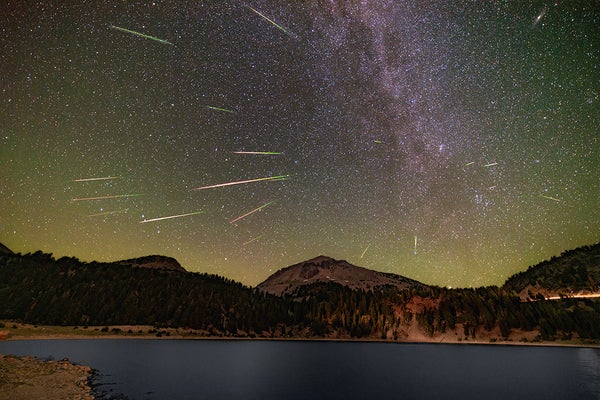Perseid Meteor Shower Joins Stunning Mars and Jupiter Conjunction
Early risers get a double sky treat: a Mars and Jupiter conjunction and the Perseid meteor shower at once
Perseid Meteor Shower over Lassen Volcanic National Park
Jerry Hamblen/Getty Images
Setting an alarm for 4:00 A.M. on August 14 is a big ask, but the payoff will be worth it: Mars and Jupiter will shine like a double star in the sky. And if you’re lucky, you’ll also see a few Perseid meteors at the same time.
All the major planets in the solar system orbit the sun in roughly the same plane, which, as seen from Earth, means they follow an imaginary line in the sky called the ecliptic. They all move at different speeds around our star, so sometimes we see one lapping another, with the two appearing close together for a short time.
Such an event is commonly called a conjunction (though “appulse” is the more technically correct term, if you want to impress people at parties). Most times the planets pass relatively far apart, but during the early morning of August 14 in the Americas, Europe and Africa, Mars and Jupiter will be a mere third of a degree apart in the sky: less than the apparent size of the full moon. (In Australia and much of Asia, this will occur on the morning of August 15.) This is a rare treat that’s worth getting up early for.
On supporting science journalism
If you’re enjoying this article, consider supporting our award-winning journalism by subscribing. By purchasing a subscription you are helping to ensure the future of impactful stories about the discoveries and ideas shaping our world today.
You won’t need any fancy equipment to see it, either. Just go outside before sunrise while the sky is still dark—from 3 to 4 A.M. is perfect—find a spot with a relatively clear horizon to the east and look up. Jupiter will be the brightest “star” in the sky, 30 degrees above the horizon (which is roughly three times the size of your fist at arm’s length). Mars will be very close to it, a red spark next to Jupiter’s more brilliant white appearance.
If you could witness this from high above the solar system, you’d see Earth, Mars and Jupiter in very nearly a perfectly straight line (technically called a syzygy, which is fun to say out loud). In reality, the two outer planets are quite far apart; Jupiter is 800 million kilometers from Earth while Mars is a mere 230 million km. Despite Mars being far closer to us, Jupiter is so much larger physically and more reflective of sunlight that the gas giant will appear 15 times brighter.
If you do have binoculars handy, you can also spot Jupiter’s four largest moons—Io, Europa, Callisto and Ganymede (itself larger than the planet Mercury)—all lined up on either side of the planet. A small telescope will also reveal broad stripes across Jupiter, which represent darker and lighter wind patterns that wrap all the way around the planet.
Mars and Jupiter will appear close together for some time before and after August 14. On such occasions, I like to go out a night or two early so I can appreciate the approach as the two planets slowly close the gap between them in the sky night after night.
There’s a bonus here, too: the annual Perseid meteor shower peaks the morning of August 12 in the U.S. but should still put on a good show two nights later, when the conjunction occurs. These small bits of rocky debris from Comet 109P/Swift-Tuttle burn up dozens of kilometers overhead in our atmosphere, zipping across the sky in less than a second. Meteor showers like this are best observed after midnight. And just like the Mars-Jupiter conjunction, you won’t need any astronomical equipment to see the Perseids. Just go outside and look up (spreading out a blanket on the ground so that you can relax as you stargaze helps considerably, too). It’s best to find a wide-open area so you maximize your chances of seeing shooting stars. (Scientific American’s guide to seeing last year’s Perseids will give you a pretty good overview of how best to spot them.)
So set your alarm, haul yourself outside and enjoy the shows. I hope you have clear skies and stellar views!

